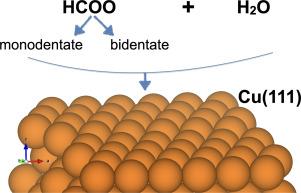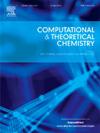Probing water–formate interactions on copper surfaces: A DFT approach to co-adsorption on Cu(111)
IF 3
3区 化学
Q3 CHEMISTRY, PHYSICAL
引用次数: 0
Abstract
Understanding water’s role in stabilizing adsorbates on metal surfaces is key to improving catalytic systems. Using density functional theory (DFT), we investigated the co-adsorption of formate (HCOO) and water on Cu(111). Three formate geometries were evaluated: bidentate (), monodentate via hydrogen (), and monodentate via oxygen (), with bidentate being the most stable. Co-adsorption with HO enhances stability: bidentate formate shows interaction energies of (one HO) and (two HO), while monodentate forms show much weaker stabilization. The approximate 0.20 eV increase in stability per added water molecule arises mainly from hydrogen bonding between water and formate oxygens. The enhanced stability in the two-water case arises from cooperative effects, where one HO forms a hydrogen bond with the formate oxygen and the second HO interacts weakly with the Cu surface. These results highlight water’s key role in stabilizing bidentate formate on Cu surfaces, reinforcing its thermodynamic preference in aqueous conditions.

探测铜表面水-甲酸盐相互作用:铜表面共吸附的DFT方法(111)
了解水在稳定金属表面吸附中的作用是改进催化系统的关键。利用密度泛函理论(DFT)研究了甲酸盐(HCOO)和水在Cu(111)上的共吸附。对三种甲酸几何形状进行了评估:双齿状(Eads=−0.82eV)、单齿状(Eads=−0.27eV)和单齿状(Eads=−0.24eV),其中双齿状最稳定。与水共吸附增强了稳定性:双齿甲酸酯的相互作用能为- 0.32eV (1 H2O)和- 0.53eV (2 H2O),而单齿甲酸酯的稳定性较弱。每加入一个水分子,稳定性增加约0.20 eV,这主要是由于水和甲酸氧之间的氢键作用。在双水的情况下,稳定性的增强来自于协同效应,其中一个H2O与甲酸氧形成氢键,另一个H2O与Cu表面弱相互作用。这些结果强调了水在Cu表面稳定双齿甲酸盐的关键作用,增强了其在水条件下的热力学偏好。
本文章由计算机程序翻译,如有差异,请以英文原文为准。
求助全文
约1分钟内获得全文
求助全文
来源期刊

Computational and Theoretical Chemistry
CHEMISTRY, PHYSICAL-
CiteScore
4.20
自引率
10.70%
发文量
331
审稿时长
31 days
期刊介绍:
Computational and Theoretical Chemistry publishes high quality, original reports of significance in computational and theoretical chemistry including those that deal with problems of structure, properties, energetics, weak interactions, reaction mechanisms, catalysis, and reaction rates involving atoms, molecules, clusters, surfaces, and bulk matter.
 求助内容:
求助内容: 应助结果提醒方式:
应助结果提醒方式:


